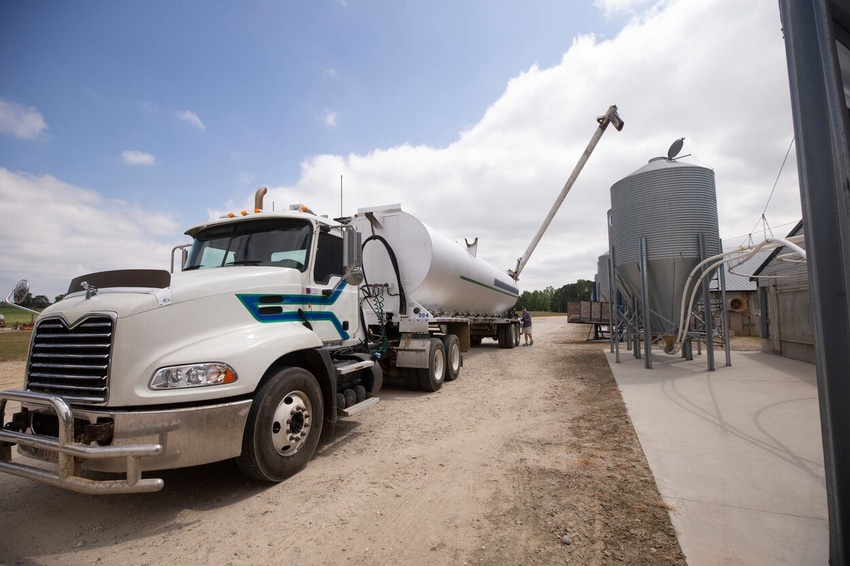US SHIP playing important role in generating industry-driven discussion on how to improve biosecurity nationwide.

When breaking down feed biosecurity and understanding a very complex feed supply, Jordan Gebhardt likes to break it down into two categories — prevention and intervention.
"We can describe them as hurdles," said Gebhardt, an assistant professor in swine production at Kansas State University. "We implement ingredient sourcing, understand where things come from. We implement biosecurity practices to prevent that contamination from occurring and then we can add additional hurdles if we would be interested in doing so and many of these are point-in-time strategies or residual approaches."
Since biosecurity is not just one single practice, but a series of hurdles, Gebhardt likes to use the analogy of a Swiss cheese model.
"That if you take one slice of Swiss cheese there is a likelihood that you can pass through without smacking into some cheese however if you layer multiple layers of Swiss cheese together the likelihood of getting through that material without coming into contact with cheese is really lower," Gebhardt says. "I think about feed safety in that manner; there's a lot of practices that have been investigated individually but really the success of a biosecurity program is the combination of multiple practices."
With prevention being the first line of defense, it’s important to understand where ingredients originate from, whether that is bulk or non-bulk ingredients, he says. While non-bulk ingredients such as bags or 1 metric ton totes can be fairly easy to track, bulk ingredients and raw materials are another story.
"Really when understanding those raw materials coming into the feed mill, we need to understand the biosecurity during manufacture and packaging, storage, as well as the transportation of those products to us as the end user," Gebhardt says.
Recent research has focused on the role of people, trucks and other fomites in pathogen spread and the information generated from those studies has led to many biosecurity measures being implemented industry wide.
The next layer in feed biosecurity is intervention or what can be done if a pathogen unintentionally gets inoculated or contaminated into material. Gebhardt says there are two mitigation strategies at this point:
Point-in-time: Feed holding time, irradiation, thermal processing (pelleting)
Residual: Having some level of residual activity to help combat possible recontamination, such as acids and alkalis, essential oils, formaldehyde-based products and medium chain fatty acids.
Because there's a number of different compounds and commercially available feed additives in this space, the K-State team has put together a summary of these products with scientific evidence evaluating efficacy against viral pathogens in swine feed.
Role of US SHIP
Feed biosecurity has also been a topic of discussion for the U.S. Swine Health Improvement Plan, with several areas focused on sampling and testing, traceability and biosecurity. For example, during the first US SHIP House of Delegates meeting a program standard was passed that states the practice of feeding swill, garbage or table waste is not permitted for participants under the US SHIP program.
A US SHIP working group of 30-plus members representing swine producers, veterinarians, nutritionists, feed ingredient suppliers, trade associations, allied industry and federal and state regulatory partners has also been distributing a series of surveys to gather feed biosecurity baseline information. One survey posed the question: do you import non-bulk ingredients (ingredients received in 1 metric ton packaging or less) from African swine fever/classical swine fever affected countries? Eight out of eight respondents reported "yes."
"That's not surprising with the way that our feed supply works. But what we found particularly eye-opening was that while many of these different producers implement some form of holding times, the degree in which they implement that practice is highly variable," Gebhardt says.
Holding times ranged from 30 to 45 to 60 days and the point in time in which that clock starts ticking (arrival in United States, upon receipt at the feed mill, and exit port of export) was even more variable. The respondents also reported a high degree of variation for storage temperature.
Another survey question asked respondents if their company uses bulk ingredients imported from countries with known ASF/CSF circulation? Of the 23 total responses, three said yes, nine said no and 11 were unknown. However, all three "yes" responses did indicate that holding time is implemented, even though there was a high degree of variation in time and temperature.
During the fall 2022 US SHIP House of Delegates meeting, two resolutions were passed to continue work of Feed Biosafety Committee and to pilot demonstration a broadly applicable responsible imports program across a substantive subset of U.S. pork industry participants and feed industry stakeholders.
A new program standard was also passed that in the event of an incursion of ASF or CSF in U.S. swine, there would be some temporary feeding modifications as it relates to feeding porcine-based ingredients back to pigs.
"Essentially there'd be some enhanced biosecurity practices we would want to include as an industry," Gebhardt says.
While the industry has generated a lot of great data in feed biosecurity, Gebhardt says the challenge now is how to implement that knowledge industry wide.
"I've been very optimistic about the interest in how willing folks are to have these discussions of how to move forward," Gebhardt says. "The US SHIP program is a terrific opportunity, an industry-driven organization, that's a mix of state associations, federal partners and our producers, all having an open discussion on how we move forward, and I see feed biosecurity as an important component of that."
About the Author(s)
You May Also Like




